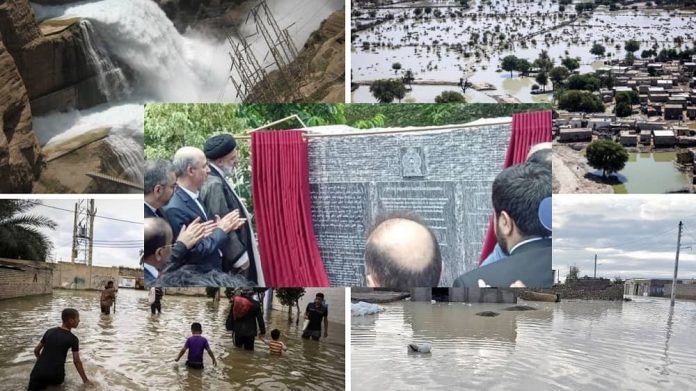Amid Dams’ Decay in Iran, Regime Forges Ahead with Dam Projects in Sri Lanka

Written by
Mohammad Sadat Khansari
Three-minute read
Floods, waterlogging, and storms have spread to 11 provinces of Iran, including Isfahan, Tehran, South Khorasan, Semnan, Sistan and Baluchestan, Fars, Qom, Golestan, Mazandaran, Kerman, and Yazd.
State media are reporting dozens of fatalities from Damghan, located in northern Iran, to the southeastern regions of Saravan, Zahedan, Fanuj, and Zarabad, due to the devastating effects of floods and storms.
Meanwhile, Ali Bahadori Jahromi, the spokesman of the Raisi government, wrote on X (formerly Twitter), “The world needs the ingenuity of Iranian youth; The Iranian-built Uma Oya dam and powerplant mega project, inaugurated with the presence of Raisi in Sri Lanka, is one of these splendid manifestations and exemplars of Iranian youth’s knowledge. Pride and dignity accompanied by the achievements of economic exports are among the outcomes of Iranian technical and engineering services.”
According to the state-run Mehr News Agency, this project began in 2016, with “officials from both countries signing it to assist Sri Lanka’s power and energy sector.” Furthermore, in mid-November 2023, state media outlets reported the inauguration of a dam in Azerbaijan.
Investing in infrastructure projects abroad is not unique to the government of Ebrahim Raisi. Previous administrations have also undertaken similar investment policies. The Iranian regime, along with affiliated companies of the Islamic Revolutionary Guard Corps (IRGC), often promote themselves as experts in dam construction. However, the extensive construction of dams on Iran’s rivers has exacerbated the country’s water scarcity crisis.
Why Is #Iran Regime Hiding Information on Dams? https://t.co/eM5JUrmytx pic.twitter.com/HcSIE8mqUG
— NCRI-FAC (@iran_policy) October 31, 2017
Since February 26, heavy rainfall has caused flooding in the southern regions of Sistan and Baluchestan province. Due to the raging floods, some parts of the dams in Baluchestan collapsed, while others overflowed due to inadequate spillways, leading to water flowing onto roads and transportation routes. Additionally, a significant portion of agricultural lands and orchards belonging to the local people were devastated.
According to reports from state media, Majid Mohebbi, the director-general of the Crisis Management Office of Sistan and Baluchestan Governorate, stated that the estimated flood damage in Baluchestan province has amounted to 1.1 trillion tomans so far, equivalent to approximately $17.6 million at current market rates. Mohebbi emphasized that the most significant damages are attributed to transportation infrastructure, the agricultural sector, and the power and water supply network.
Furthermore, Mostafa Beyk Maddah, the director-general of the Housing Foundation of Sistan and Baluchestan, announced damages to over 2,150 residential and urban units in the province. Additionally, state media reported that the recent heavy rains in southern Sistan and Baluchestan led to the overflowing of the Khairabad Nikshahr Dam and the Kahir Dam in Khash County.
#Iran News in Brief
Devastating floods and overflowing dams have left a trail of destruction in Iran. At least seven lives lost, over 59 injured, and countless houses destroyed.https://t.co/S9TovUJxqO pic.twitter.com/LwTPF3GzCv— NCRI-FAC (@iran_policy) June 9, 2023
It is evident that the people of Iran in general, and the flood-affected regions in particular, are in dire need of assistance and investment in the country’s infrastructure. Currently, many areas of the country require reconstruction and renovation of dams to maximize water retention. The dams built in flood-prone areas lack the capacity to withstand severe floods due to their deteriorating structure, leading to their collapse and the ensuing devastating floods.
However, instead of focusing on the construction and renovation of dams in these regions, the regime is investing in building dams in other countries using the money from the pockets of the Iranian people.
Over the past few decades, as the regime has strengthened its influence in the region by investing in paramilitary forces in neighboring countries, Tehran has sought to establish dependent states and build alliances through such extravagant spending. These expenditures serve to sway votes in international assemblies or establish foundations for extremist forces.
As Tehran’s investments in the Middle East yield results, it becomes increasingly crucial to isolate the world’s leading state sponsor of terrorism and undermine its ambitious initiatives.

